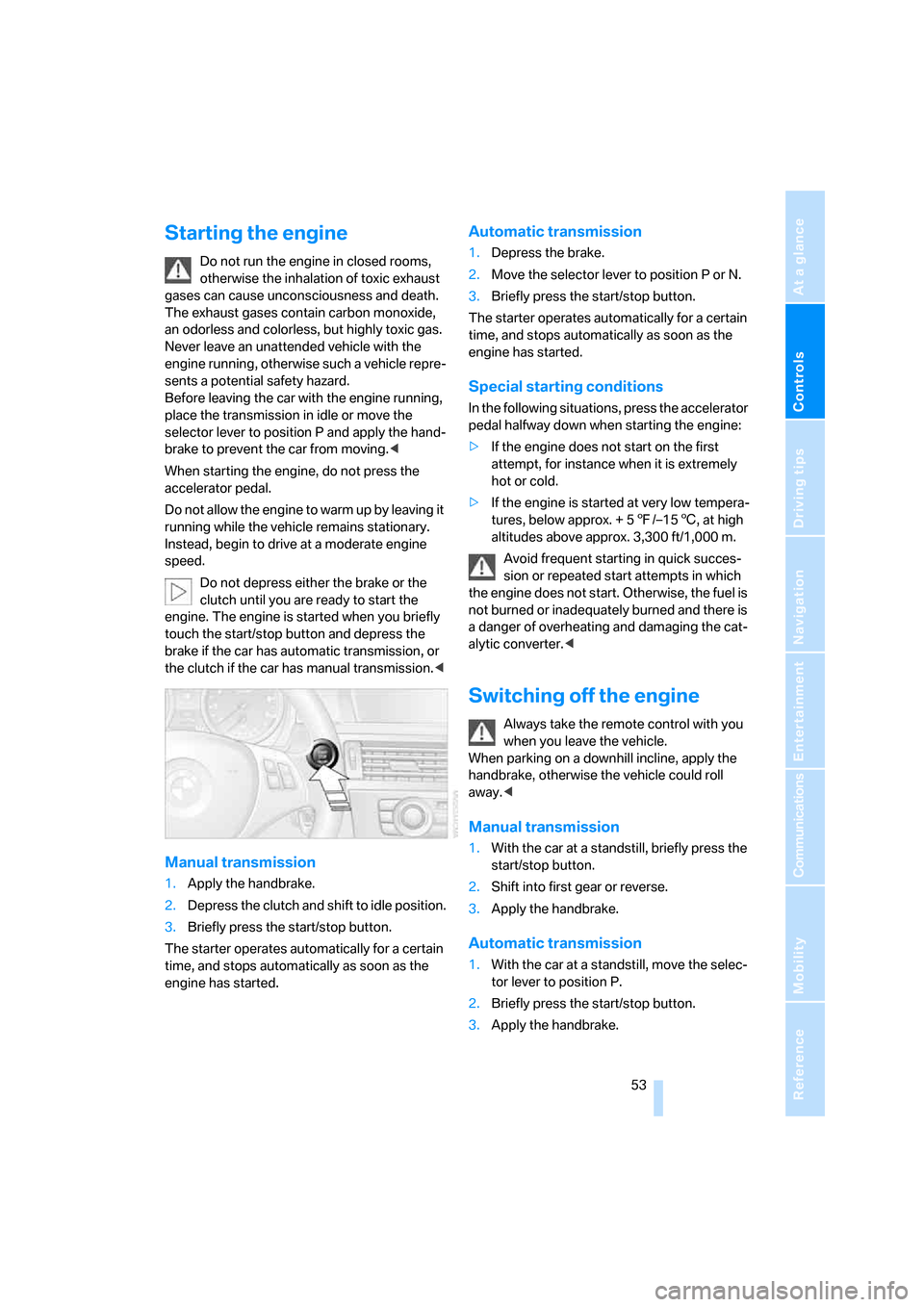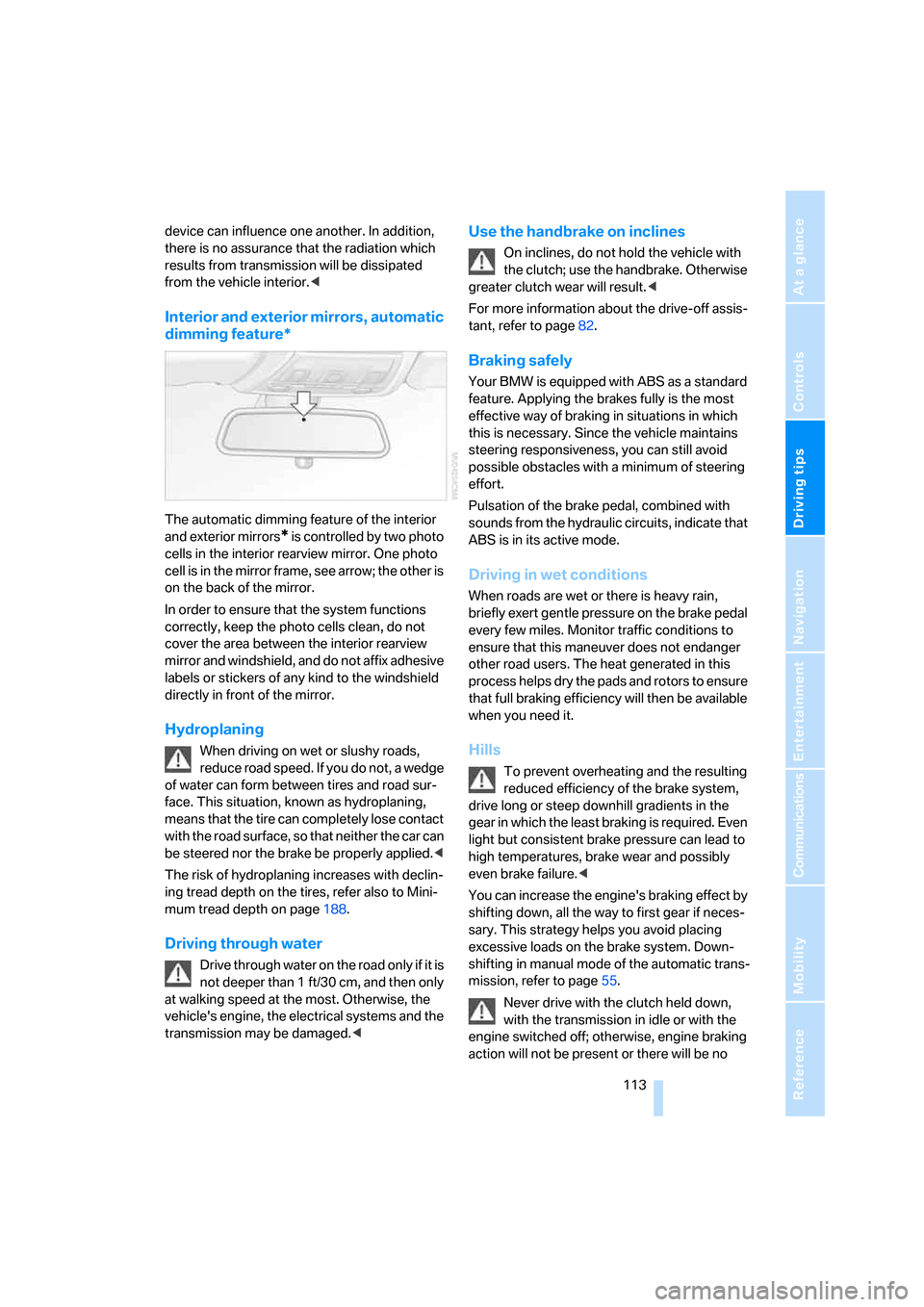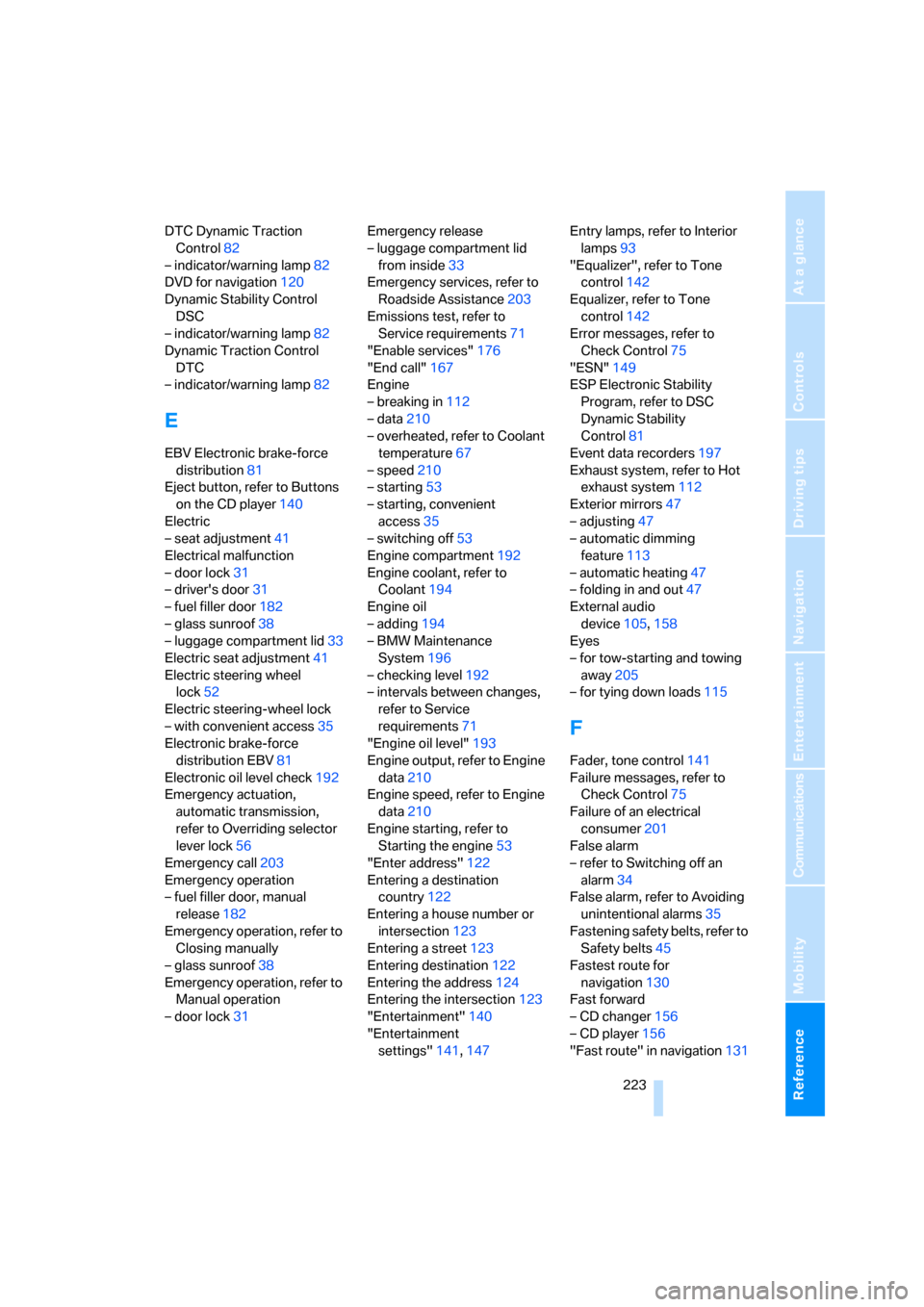2006 BMW 328I COUPE engine overheat
[x] Cancel search: engine overheatPage 55 of 239

Controls
53Reference
At a glance
Driving tips
Communications
Navigation
Entertainment
Mobility
Starting the engine
Do not run the engine in closed rooms,
otherwise the inhalation of toxic exhaust
gases can cause unconsciousness and death.
The exhaust gases contain carbon monoxide,
an odorless and colorless, but highly toxic gas.
Never leave an unattended vehicle with the
engine running, otherwise such a vehicle repre-
sents a potential safety hazard.
Before leaving the car with the engine running,
place the transmission in idle or move the
selector lever to position P and apply the hand-
brake to prevent the car from moving.<
When starting the engine, do not press the
accelerator pedal.
Do not allow the engine to warm up by leaving it
running while the vehicle remains stationary.
Instead, begin to drive at a moderate engine
speed.
Do not depress either the brake or the
clutch until you are ready to start the
engine. The engine is started when you briefly
touch the start/stop button and depress the
brake if the car has automatic transmission, or
the clutch if the car has manual transmission.<
Manual transmission
1.Apply the handbrake.
2.Depress the clutch and shift to idle position.
3.Briefly press the start/stop button.
The starter operates automatically for a certain
time, and stops automatically as soon as the
engine has started.
Automatic transmission
1.Depress the brake.
2.Move the selector lever to position P or N.
3.Briefly press the start/stop button.
The starter operates automatically for a certain
time, and stops automatically as soon as the
engine has started.
Special starting conditions
In the following situations, press the accelerator
pedal halfway down when starting the engine:
>If the engine does not start on the first
attempt, for instance when it is extremely
hot or cold.
>If the engine is started at very low tempera-
tures, below approx. + 57/–156, at high
altitudes above approx. 3,300 ft/1,000 m.
Avoid frequent starting in quick succes-
sion or repeated start attempts in which
the engine does not start. Otherwise, the fuel is
not burned or inadequately burned and there is
a danger of overheating and damaging the cat-
alytic converter.<
Switching off the engine
Always take the remote control with you
when you leave the vehicle.
When parking on a downhill incline, apply the
handbrake, otherwise the vehicle could roll
away.<
Manual transmission
1.With the car at a standstill, briefly press the
start/stop button.
2.Shift into first gear or reverse.
3.Apply the handbrake.
Automatic transmission
1.With the car at a standstill, move the selec-
tor lever to position P.
2.Briefly press the start/stop button.
3.Apply the handbrake.
ba8_E9293_US.book Seite 53 Freitag, 5. Mai 2006 1:02 13
Page 115 of 239

Driving tips
113Reference
At a glance
Controls
Communications
Navigation
Entertainment
Mobility
device can influence one another. In addition,
there is no assurance that the radiation which
results from transmission will be dissipated
from the vehicle interior.<
Interior and exterior mirrors, automatic
dimming feature*
The automatic dimming feature of the interior
and exterior mirrors
* is controlled by two photo
cells in the interior rearview mirror. One photo
cell is in the mirror frame, see arrow; the other is
on the back of the mirror.
In order to ensure that the system functions
correctly, keep the photo cells clean, do not
cover the area between the interior rearview
mirror and windshield, and do not affix adhesive
labels or stickers of any kind to the windshield
directly in front of the mirror.
Hydroplaning
When driving on wet or slushy roads,
reduce road speed. If you do not, a wedge
of water can form between tires and road sur-
face. This situation, known as hydroplaning,
means that the tire can completely lose contact
with the road surface, so that neither the car can
be steered nor the brake be properly applied.<
The risk of hydroplaning increases with declin-
ing tread depth on the tires, refer also to Mini-
mum tread depth on page188.
Driving through water
Drive through water on the road only if it is
not deeper than 1 ft/30 cm, and then only
at walking speed at the most. Otherwise, the
vehicle's engine, the electrical systems and the
transmission may be damaged.<
Use the handbrake on inclines
On inclines, do not hold the vehicle with
the clutch; use the handbrake. Otherwise
greater clutch wear will result.<
For more information about the drive-off assis-
tant, refer to page82.
Braking safely
Your BMW is equipped with ABS as a standard
feature. Applying the brakes fully is the most
effective way of braking in situations in which
this is necessary. Since the vehicle maintains
steering responsiveness, you can still avoid
possible obstacles with a minimum of steering
effort.
Pulsation of the brake pedal, combined with
sounds from the hydraulic circuits, indicate that
ABS is in its active mode.
Driving in wet conditions
When roads are wet or there is heavy rain,
briefly exert gentle pressure on the brake pedal
every few miles. Monitor traffic conditions to
ensure that this maneuver does not endanger
other road users. The heat generated in this
process helps dry the pads and rotors to ensure
that full braking efficiency will then be available
when you need it.
Hills
To prevent overheating and the resulting
reduced efficiency of the brake system,
drive long or steep downhill gradients in the
gear in which the least braking is required. Even
light but consistent brake pressure can lead to
high temperatures, brake wear and possibly
even brake failure.<
You can increase the engine's braking effect by
shifting down, all the way to first gear if neces-
sary. This strategy helps you avoid placing
excessive loads on the brake system. Down-
shifting in manual mode of the automatic trans-
mission, refer to page55.
Never drive with the clutch held down,
with the transmission in idle or with the
engine switched off; otherwise, engine braking
action will not be present or there will be no
ba8_E9293_US.book Seite 113 Freitag, 5. Mai 2006 1:02 13
Page 225 of 239

Reference 223
At a glance
Controls
Driving tips
Communications
Navigation
Entertainment
Mobility
DTC Dynamic Traction
Control82
– indicator/warning lamp82
DVD for navigation120
Dynamic Stability Control
DSC
– indicator/warning lamp82
Dynamic Traction Control
DTC
– indicator/warning lamp82
E
EBV Electronic brake-force
distribution81
Eject button, refer to Buttons
on the CD player140
Electric
– seat adjustment41
Electrical malfunction
– door lock31
– driver's door31
– fuel filler door182
– glass sunroof38
– luggage compartment lid33
Electric seat adjustment41
Electric steering wheel
lock52
Electric steering-wheel lock
– with convenient access35
Electronic brake-force
distribution EBV81
Electronic oil level check192
Emergency actuation,
automatic transmission,
refer to Overriding selector
lever lock56
Emergency call203
Emergency operation
– fuel filler door, manual
release182
Emergency operation, refer to
Closing manually
– glass sunroof38
Emergency operation, refer to
Manual operation
– door lock31Emergency release
– luggage compartment lid
from inside33
Emergency services, refer to
Roadside Assistance203
Emissions test, refer to
Service requirements71
"Enable services"176
"End call"167
Engine
– breaking in112
– data210
– overheated, refer to Coolant
temperature67
– speed210
– starting53
– starting, convenient
access35
– switching off53
Engine compartment192
Engine coolant, refer to
Coolant194
Engine oil
– adding194
– BMW Maintenance
System196
– checking level192
– intervals between changes,
refer to Service
requirements71
"Engine oil level"193
Engine output, refer to Engine
data210
Engine speed, refer to Engine
data210
Engine starting, refer to
Starting the engine53
"Enter address"122
Entering a destination
country122
Entering a house number or
intersection123
Entering a street123
Entering destination122
Entering the address124
Entering the intersection123
"Entertainment"140
"Entertainment
settings"141,147Entry lamps, refer to Interior
lamps93
"Equalizer", refer to Tone
control142
Equalizer, refer to Tone
control142
Error messages, refer to
Check Control75
"ESN"149
ESP Electronic Stability
Program, refer to DSC
Dynamic Stability
Control81
Event data recorders197
Exhaust system, refer to Hot
exhaust system112
Exterior mirrors47
– adjusting47
– automatic dimming
feature113
– automatic heating47
– folding in and out47
External audio
device105,158
Eyes
– for tow-starting and towing
away205
– for tying down loads115
F
Fader, tone control141
Failure messages, refer to
Check Control75
Failure of an electrical
consumer201
False alarm
– refer to Switching off an
alarm34
False alarm, refer to Avoiding
unintentional alarms35
Fastening safety belts, refer to
Safety belts45
Fastest route for
navigation130
Fast forward
– CD changer156
– CD player156
"Fast route" in navigation131
ba8_E9293_US.book Seite 223 Freitag, 5. Mai 2006 1:02 13
Page 230 of 239

Everything from A - Z
228 Neck support, refer to Head
restraints42
Nets, refer to Storage
compartments105
"New address" in
navigation128
"New destination"121,125
"New route"136
New tires189
"Next entertainment
source"48
North-facing map134
Nose weight212
Nozzles95
Number of cylinders, refer to
Engine data210
Nylon rope, refer to Tow
rope206
O
OBD socket, refer to Socket
for On-Board Diagnosis197
Octane ratings, refer to Fuel
specifications182
Odometer66
Oil
– capacity213
Oil, refer to Engine oil192
Oil consumption192
Oil level192
Old batteries, refer to
Disposal201
"On a new destination" in
navigation127
"Onboard info"68
Onboard tool kit198
"On destination"127
"On location"127
Opening and closing
– convenient access35
– from inside32
– from outside29
– using the door lock31
– via the remote control29Operation by voice for mobile
phone171
– adjusting volume172
– canceling171
– correcting phone
number172
– dialing phone number172
– placing a call172
– redialing173
– voice commands171
– voice phone book172
Orientation menu, refer to
Start menu17
Outlets
– refer to Ventilation98
Output, refer to Engine
data210
Outside-air mode
– automatic climate control97
Outside-temperature
display66
– changing units of
measure70
– in computer70
Outside temperature
warning66
Overheated engine, refer to
Coolant temperature67
Overriding selector lever
lock56
P
Park assistant, refer to Park
Distance Control80
"Parked car operation"99
"Parked car ventilation"99
Parked car ventilation99
Parked car ventilation/heating
– activating switch-on
times100
– preselecting switch-on
times99
– switching on and off
directly99
Parking
– vehicle53
Parking aid, refer to PDC Park
Distance Control80Parking brake, refer to
Handbrake54
Parking lamps90
Parking lamps/low beams90
Passenger-side mirror tilt
function47
"Pathway lighting"91
Pathway lighting91
"PDC"80
PDC Park Distance Control80
Personal Profile28
"Perspective"134
Phone book166
Phone numbers
– deleting from phone
book169
– dialing167
– most recent numbers168
– selecting in phone book168
– Top 8168
Pinch protection system
– glass sunroof, electric38
– windows37
Placing a call, refer to
telephone owner's manual
"Play" for audio mode153
"Play" for satellite radio150
Pollen
– refer to Microfilter/activated-
charcoal filter for automatic
climate control99
Position
– displaying136
– saving, refer to Storing
current position128
Power failure201
Power seats41
Power windows37
Power windows, refer to
Windows37
Preselecting the switch-on
times for parked car
ventilation/heating99
"Presets", displaying with the
radio144
"Presets" for satellite
radio150
Pressure, tires
184
ba8_E9293_US.book Seite 228 Freitag, 5. Mai 2006 1:02 13